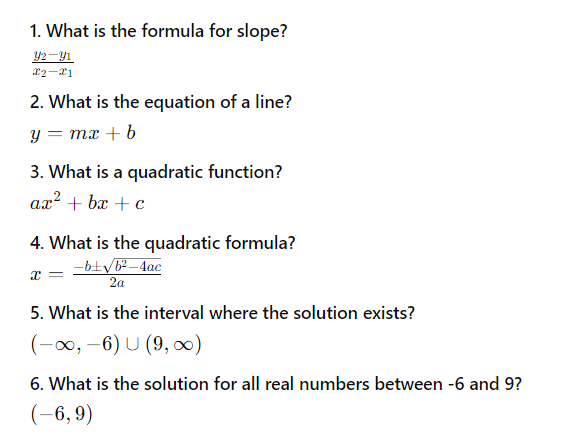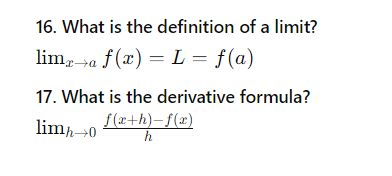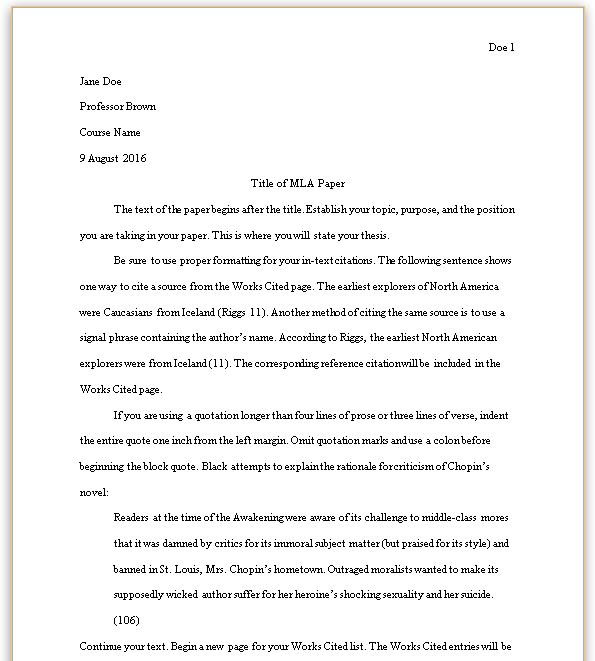1. What is the formula for slope?
y2−y1x2−x1\frac{y_2 – y_1}{x_2 – x_1}
2. What is the equation of a line?
y=mx+by = mx + b
3. What is a quadratic function?
ax2+bx+cax^2 + bx + c
4. What is the quadratic formula?
x=−b±b2−4ac2ax = \frac{-b \pm \sqrt{b^2 – 4ac}}{2a}
5. What is the interval where the solution exists?
(−∞,−6)∪(9,∞)(-\infty, -6) \cup (9, \infty)
6. What is the solution for all real numbers between -6 and 9?
(−6,9)(-6, 9)

7. What does break-even mean in economics?
Cost = Revenue or Profit = 0
8. What is the revenue function?
Price * Number of Units
9. What is the profit function?
Revenue – Cost
10. What is the cost function?
Variable Cost * Number of Units + Fixed Cost
Suppose a company has fixed cost of $45 and variable cost per unit of 17x+917x + 9 dollars, where xx is the total number of units produced. Suppose further that the selling price of its product is 18−67×18 – 67x dollars per unit.
11. Find the simplified cost function, C(x)C(x).
- a. $45
- b. 17×2+9x17x^2 + 9x
- c. 17×2+9x+4517x^2 + 9x + 45
- d. 17×2+54x17x^2 + 54x
- e. None of these
Answer: c. 17×2+9x+4517x^2 + 9x + 45
12. Find the simplified revenue function, R(x)R(x).
- a. 18x−67x218x – 67x^2
- b. 18x−67×2−4518x – 67x^2 – 45
- c. 18x−67x18x – 67x
- d. $45
- e. None of these
Answer: a. 18x−67x218x – 67x^2
13. Find the simplified profit function, P(x)P(x).
- a. x2−9x−45x^2 – 9x – 45
- b. −x2+9x−45-x^2 + 9x – 45
- c. −17×2+9x-17x^2 + 9x
- d. $0
- e. None of these
Answer: b. −x2+9x−45-x^2 + 9x – 45
14. What is the relationship between marginal revenue and the slope of the revenue function?
- a. There is no relationship.
- b. Marginal revenue is the negative reciprocal of the slope.
- c. They are the same.
Answer: c. They are the same.
15. What does it mean for a function to be differentiable at a point?
- a. The limit as xx approaches the point does not exist.
- b. The function is not continuous at the point but is differentiable at the point.
- c. The function is continuous and differentiable at that point.
- d. The function is continuous at the point but is not differentiable at the point.
- e. None of these.
Answer: c. The function is continuous and differentiable at that point.
16. What is the definition of a limit?
limx→af(x)=L=f(a)\lim_{x \to a} f(x) = L = f(a)
17. What is the derivative formula?
limh→0f(x+h)−f(x)h\lim_{h \to 0} \frac{f(x + h) – f(x)}{h}



